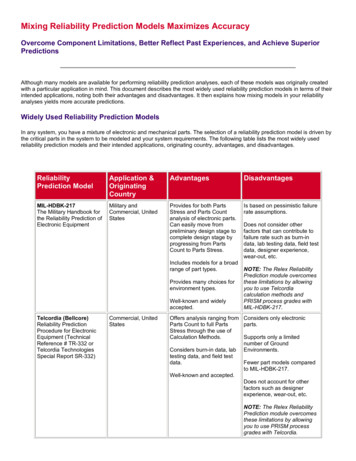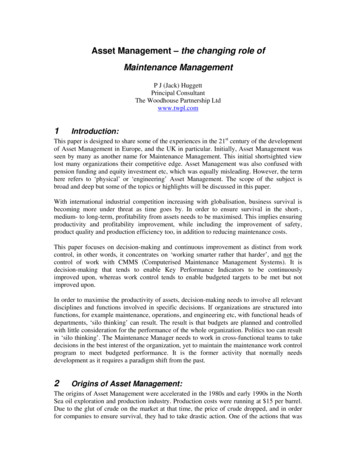Electronic Parts Reliability Data 2014
Electronic PartsReliability Data 2014
Ordering Number: EPRD-2014Electronic PartsReliability Data2014Prepared by:Quanterion Solutions Incorporated100 Seymour Rd.Suite C101Utica, NY 13502-1311Prepared for:Reliability Information Analysis Center100 Seymour Rd.Suite C101Utica, NY 13502-1311
The information and data contained herein have been compiled from governmentand nongovernment technical reports and from material supplied by variousmanufacturers and are intended to be used for reference purposes. Neither theUnited States Government nor Quanterion Solutions Incorporated warrant theaccuracy of this information and data. The user is further cautioned that the datacontained herein may not be used in lieu of other contractually cited references andspecifications.Publication of this information is not an expression of the opinion of the UnitedStates Government or Quanterion Solutions Incorporated as to the quality ordurability of any product mentioned herein and any use for advertising orpromotional purposes of this information in conjunction with the name of theUnited States Government or Quanterion Solutions Incorporated without writtenpermission is expressly 4-67-4978-1-933904-67-2(CD-ROM)(CD-ROM)Copyright 2014 by Quanterion Solutions Incorporated. This hand book w as d eveloped by QuanterionSolutions Incorporated for the Departm ent of Defense Reliability Inform ation Analysis Center (RIAC) und erContract H C1047-05-D-4005. The Governm ent has a fully paid up perpetual license for free use of and access tothis publication and its contents am ong all the DOD IACs in both hard copy and electronic versions, w ithoutlim itation on the num ber of users or servers. Subject to the rights of the Governm ent, this d ocum ent (hard copyand electronic versions) and the content contained w ithin it are protected by U.S. Copyright Law and m ay notbe copied , autom ated , re-sold , or red istributed to m ultiple users w ithout the express w ritten perm ission. Thecopyrighted w ork m ay not be m ad e available on a server for use by m ore than one person sim ultaneouslyw ithout the express w ritten perm ission. If autom ation of the technical content for other than personal use, or form ultiple sim ultaneous user access to a copyrighted w ork is d esired , please contact 877.808.0097 (toll free) or315.732.0097 for licensing inform ation.
TABLE OF CON TEN TSPAGESECTION 1:1.11.21.31.4IN TRODUCTIONBackgrou nd . Data Collection . .Data Interp retation . . Docu m ent Overview . ectionSectionSectionSectionSection2 “Part Sum m aries” Overview . .3 “Part Details” Overview . .4 “Data Sources” Overview . .5 “Part N um ber/ MIL N um ber” Ind ex . .6 “N ational Stock N um ber Ind ex w ith Fed eral Stock Class ” . .7 “N ational Stock N um ber Ind ex w ithout Fed eral Stock Class Prefix” .8 “Part Description Ind ex” . 1-11-31-41-71-71-131-141-151-151-151-25SECTION 2:PART SUMMARIES2-1SECTION 3:PART DETAILS3-1SECTION 4:DATA SOURCES4-1SECTION 5:PART/ MIL N UMBER IN DEX5-1SECTION 6:N ATION AL STOCK N UMBER IN DEX WITH FEDERAL STOCK CLASS6-1SECTION 7:N ATION AL STOCK N UMBER IN DEX WITH OUT FEDERAL STOCK CLASS7-1SECTION 8:PART DESCRIPTION IN DEX8-1LIST OF TABLESTABLE 1-1:TABLE 1-2:TABLE 1-3:TABLE 1-4:TABLE 1-5:TABLE 1-6:DATA SUMMARIZATION PROCEDURECOMPON EN T GROWTH RATE FACTORS (FROM EPRD-97)FIELD DESCRIPTION SPART DESCRIPTION SAPPLICATION EN VIRON MEN TSCOMMON ABBREVIATION S1-31-61-81-91-91-14LIST OF FIGURESFIGURE 1-1:EXAMPLE OF PART SUMMARY EN TRIESiv1-12
EPRD-20141.0Introduction1-1INTRODUCTIONThis document represents a major update to the previous Electronic Part Reliability Data (EPRD-97)databook published over 15 years ago. Its purpose is to provide empirical field failure rate data onelectronic components. EPRD-97 data was limited to Capacitors, Diodes, Integrated Circuits,Optoelectronic Devices, Resistors, Thyristors, Transformers, and Transistors. EPRD-2014 adds millionsof hours of operating time and hundreds of failures to these component types, as well as adding (andupdating) field failure rate data on electronic Connectors, Relays, Switches, Inductors/Coils, previouslycontained only in the Reliability Information Analysis Center (RIAC) Nonelectronic Part Reliability Data(NPRD-2011) release.Reliability data is required to perform reliability assessments of systems. The part types for which datais contained in this document are those contained in existing reliability prediction methodologies, such asMIL-HDBK-217F, Notice 2 and. Whereas MIL-HDBK-217 and 217PlusTM contain mathematical modelsthat have been derived from empirical field failure rate data, the data contained in EPRD-2014 representshistorically observed field failure rates. This data can be used as an alternative to existing predictionmethodologies.Commercial quality components continue to be widely used in many applications, including militarysystems. Much of the data contained in this document relates to commercial quality components. It can,therefore, be used to predict reliability for both commercial and military systems containing commercialquality components.EPRD-2014, in combination with NPRD-2011, provides the capability of estimating the reliability ofmost component and assembly types used in electronic or mechanical systems.1.1 BackgroundAccurate and timely reliability predictions are an important part of a well structured reliability program.If properly performed, they can provide insight into the design and maintenance of reliable systems, aswell as provide initial estimates for sparing requirements.A potential use for this document is to complement existing reliability prediction methodologies byproviding failure rate data in a consistent format on various electronic component types when anorganization does not have its own database of failure rates for its own products/systems. Although thedata contained in this publication was collected from a wide variety of sources, the RIAC has carefullyand systematically screened the data such that only high quality data is added to the database andpresented in this document. In addition, only field failure rate data has been included.The user of this document should note that the use of reliability prediction techniques such as 217PlusTMor MIL-HDBK-217, or the use of the data contained in EPRD-2014, should complement (and must notreplace) sound reliability engineering and design practices. This document is meant to provide historicalreliability data on a wide variety of components to aid engineers in estimating the reliability of systems.Sound reliability engineering practices must include knowledge of the failure physics of all components,modules and interconnection assemblies in a system. Knowledge of life-limiting failure mechanisms,and how these mechanisms will behave in the intended use environment, is also necessary. Only in thismanner can robust designs be ensured.The intent of this introductory section is to provide the user with information to adequately interpret anduse the data. Since the primary purpose of this document is to augment reliability predictionmethodologies such as 217PlusTM and MIL-HDBK-217, a brief background of MIL-HDBK-217 will begiven, along with a description of how the data in this document can be used to augment it.100 Seymour Rd., Suite C101, Utica, NY 13502-1311 Ph: 877.808.0097
1-2 IntroductionEPRD-2014WHAT IS THE PURPOSE OF PERFORMING A RELIABILITY PREDICTION?1Predictions have several purposes, among them are:(1) feasibility evaluation(2) comparing competing designs(3) identification of potential reliability problems(4) to provide reliability input to other R/M tasksFeasibility evaluation involves evaluating the compatibility of a proposed design concept with the design reliabilityrequirements. Early in the system formulation process a feasibility evaluation would typically take the form of a parts counttype prediction (MIL-HDBK-217F, Appendix A) to determine "ballpark" compatibility with required reliability. Feasibilityevaluation may also take the form of a detailed parts stress type analysis (MIL-HDBK-217F, Sections 5-23) for componentsused in very high quantities. One example might be for phase shifter modules on a phased array antenna. Feasibilityevaluation is much more critical for totally new design concepts where no similar earlier system exists than for systems withknown reliability performance.Comparing competing designs is similar to the feasibility evaluation except that it extends through the design process andprovides one input, the predicted reliability, to be used in making broader system level design trade-off decisions involvingfactors such as cost, weight, power, performance, etc. A parts stress type prediction is typically refined to provide aquantitative means of estimating the relative cost-benefit of these and other system level trade-off considerations.Predictions which are properly performed provide a methodical means of checking all components for potential reliabilityproblems. By focusing attention on lower quality, over-stressed or misapplied parts a relative means of evaluating thereliability impact of these potential problem areas can be performed. It should be emphasized that the prediction itself doesnot improve system reliability; it only provides a means for identifying potential problems that, if corrected, will lead toimproved systems reliability. Therefore, predictions provide an excellent vehicle for government/contractor dialog inreviewing and evaluating the progress of the design prior to testing.Predictions provide key input to other R/M tasks such as maintainability analysis, testability evaluation and failure modes andeffects analysis (FMEA). Because predictions identify areas of relatively low reliability they provide key input to weigh thebenefits of adding test points, making areas more readily accessible for maintenance or adding redundancy to reduce the effectof a particularly critical failure mode.WHAT IS THE PURPOSE OF MIL-HDBK-217?MIL-HDBK-217 is intended to provide a consistent and uniform data base for making reliability predictions when nosubstantial reliability experience exists for a particular equipment. It contains two basic methods of calculating componentlevel failure rates, the "parts stress method" and the "parts count method." The parts count method requires only limitedinformation such as component type, complexity and part quality to calculate a part failure rate. The parts count section of thehandbook is derived by assigning model factors for more involved part stress method to slightly conservative estimates of whatwould typically be expected. All of the specific default values are provided in Appendix A of the handbook. The parts stressmethod requires significantly more information such as case or junction temperature and electrical operating and ratedconditions to perform a failure rate calculation. Prior to the development of the handbook, each contractor would have its ownunique set of data of which the source would have to be fully understood before meaningful design comparisons could bemade.It is not feasible for documents like 217PlusTM, MIL-HDBK-217, or other prediction methodologies tocontain failure rate models on every conceivable type of component and assembly. Traditionally,reliability prediction models have been primarily applicable only for generic electronic components.Therefore, EPRD-2014 serves a number of different needs, such as:1. Provide failure rate data on commercial quality components2. Provide failure rates on components in cases where data or analyses are not otherwiseavailable, feasible or required1excerpt from the Reliability Analysis Center (RAC) April 1990 Newsletter Technical Brief, written by Seymour Morris of Rome Laboratory.Quanterion Solutions Incorporated
EPRD-2014Introduction1-33. Complement 217PlusTM, MIL-HDBK-217 and other prediction methodologies by providingdata on part types not addressed by their respective models1.2 Data CollectionThe failure rate data contained in this document represent a cumulative compilation from the early 1970'sthrough July 2013. However, it should be noted that data is periodically purged from the database in theevent that newer data of higher quality is obtained. The RIAC is continuously soliciting new field data inan effort to keep the databases current. The goals of these data collection efforts are to:1. Obtain data on relatively new part types and assemblies2. Collect as much data on as many different data sources, application environments, andquality levels as possible3. Identify as many characteristic details as possible, including both part and applicationparametersThe RIAC utilized the following generic sources of data for EPRD-2014: Published reports and papersData collected from government-sponsored studiesData collected from military maintenance data collection systemsData collected from commercial warranty repair systemsData from commercial/industrial maintenance databasesData submitted directly to RAC from military or commercial organizations that maintain failuredatabasesBrief descriptions are provided of the sources utilized in this document. Each summarized failure ratecan be mapped to one of these data sources. An example of the process by which RIAC identifiescandidate systems and extracts reliability data on military systems is summarized in Table 1-1.Table 1-1: Data Summarization Procedure(1)Identify System Based On: Environments/QualityAgeComponent TypesAvailability of Quality Data(2)Build Parts List: Obtain Illustrated Parts Breakdown
updating) field failure rate data on electronic Connectors, Relays, Switches, Inductors/Coils, previously contained only in the Reliability Information Analysis Center (RIAC) Nonelectronic Part Reliability Data (NPRD-2011) release. Reliability data is required to perform reliability assessments of systems. The part types for which data
Test-Retest Reliability Alternate Form Reliability Criterion-Referenced Reliability Inter-rater reliability 4. Reliability of Composite Scores Reliability of Sum of Scores Reliability of Difference Scores Reliability
Electronic Parts Reliability Data (2000 pages) Nonelectronic Parts Reliability Data (1000 pages) Nonoperating Reliability Databook (300 pages) Recipe books: Recipe book: MIL-HDBK-217F Military Handbook 338B: Electronic Reliability Design Handbook Automotive Electronics Reliability SP-696 Reliability references:
Electronic Parts Reliability Data (2000 pages) Nonelectronic Parts Reliability Data (1000 pages) Nonoperating Reliability Databook (300 pages) Recipe books: Recipe book: MIL-HDBK-217F Military Handbook 338B: Electr onic Reliability Design Handbook Automotive Electronics Reliability SP-696 Reliability references:
Considers only electronic parts. Cannot model hybrids. No reference standard available. NPRD/EPRD Nonelectronics Parts Reliability (NPRD) and Electronic Parts Reliability (EPRD) databases by RAC Military and Commercial, United States Broad array of electronic and non-electronic parts. Based completely on field data. Consists entirely of databases
Reliability The probability that a system (or component) will fail at or after a predetermined time t Failures rate sources Manufacturer Historical Data Ancillary handbooks –Non-electronic Parts Reliability Database (NPRD) 2016, Electronic Parts Reliability Database (EPRD) 2014 Mean Time Between Failures (MTBF)
Reliability Infrastructure: Supply Chain Mgmt. and Assessment Design for reliability: Virtual Qualification Software Design Tools Test & Qualification for reliability: Accelerated Stress Tests Quality Assurance System level Reliability Forecasting: FMEA/FMECA Reliability aggregation Manufacturing for reliability: Process design Process variability
posing system reliability into component reliability in a deterministic manner (i.e., series or parallel systems). Consequentially, any popular reliability analysis tools such as Fault Tree and Reliability Block Diagram are inadequate. In order to overcome the challenge, this dissertation focuses on modeling system reliability structure using
Asset Management has now spread to many utility organizations and large and small companies are adopting similar programs. 3 The changing role of Maintenance Management in Asset Management: To illustrate how maintenance managers can contribute to an Asset Management improvement program, the table below lists some common issues facing management in the first column, and thoughts on how these .























